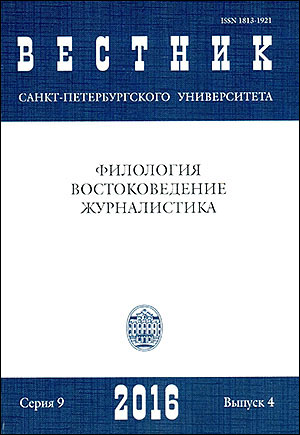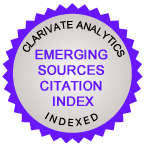Ecotranslatology as a Model of Translation
DOI:
https://doi.org/10.21638/11701/spbu09.2016.408Abstract
The article discusses the concept of ecotranslatology developed by Hu Gengshen, a Chinese researcher of Translation Studies (2003). The concept is based on the ancient principles of the Chinese philosophy claiming harmony in antinome. Many principles of modern translatology fit in well with the ecotrans- latology system: translator’s selection and adaptation to the environment, relationship between the individual and the collective; creativity and usage; interdependence of the contextual factors, a client, and a translator. This concept is of great importance for intermediary (indirect) translation when a source language is a lingua franca rather than a native language of the author, with pluricentric Eng- lish in its numerous varieties (Chinese, Japanese, Korean, a.o.) functioning as a lingua franca in the international setting. Adaptation of a translator, who received a traditional linguistic and translation training at a school of West European languages, to translating Asian culture-loaded words borrowed into English and to interpreting oral texts with traces of transfer from Asian languages, native to speak- ers — traces that are evident in local varieties of English — requires special skills and qualification. Harmony of ecotranslation environment components — text, languages, translation, author, receptor, and client — can be achieved when observing the principle of translation convertibility (Kabakchi 1998; Proshina 2014) that regulates the relationship of a source and target texts based on the regulari- ties of intermediary rather than direct translation. Studying these regularities should be included in the curricula of translation departments with schools of West European languages.
Downloads
References
Библиография:
Кабакчи В. В. Основы англоязычной межкультурной коммуникации. СПб.: РГПУ им. А. И. Герцена, 1998. 228 с.
Кушнина Л. В., Пылаева Е. М. Экология перевода: современные тенденции и подходы // Вестник Пермского университета. Российская и зарубежная филология. 2014. № 2 (26). С. 70–76.
Миньяр-Белоручев Р. К. Теория и методы перевода. М.: Московский лицей, 1996. 208 с.
Прошина З. Г. Опосредованный перевод в перспективе экотранслатологии // Вестник Московского университета. Сер. 19. Лингвистика и межкультурная коммуникация. 2013. № 4. С. 9–17.
Прошина З. Г. Опосредованный перевод и принцип обратимости перевода // Социальные и гуманитарные науки на Дальнем Востоке. 2014. № 1 (41). С. 179–184.
Слог и ритм английской речи в странах Восточной и Юго-Восточной Азии (Китай, Республика Корея, Япония, Вьетнам, Таиланд) / под ред. Л. П. Бондаренко. Владивосток: Дальневост. ун-т, 2007. 176 с.
Смоленский В. СУСИ или СУШИ? Отповедь шепелявящим // Виртуальные суси. 1998. URL: http:// www.susi.ru/SusiOrSushi.html (дата обращения: 03.01.2016).
Федюченко Л. Г. Экологический аспект перевода: переводческая ошибка // Вестник Тюменского государственного университета. 2012. № 1. С. 97–102.
Чистова Е. В. Эколингвистические проблемы перевода в эпоху глобанглизации и глокализации // Экология языка и коммуникативная практика. 2015. № 1. С. 269–281.
Шевнин А. Б. Переводческая эрратология: Теория и практика. Екатеринбург: УрГИБ, 2010. 138 с.
Cronin M. Translation and Globalization. London; New York: Routledge, 2003. 197 p.
Dollerup C. Chinese Eco-Translatology in Translation Theory Contexts // The First International Conference on Eco-translalogy. Macau. 2010. Abstracts of Paper. URL: http://www.cay-dollerup.dk/publications. asp. (accessed 31.07.2016).
Hongyin W. [Rev.] Xu Jianzhong. Translation Ecology. [In Chinese]. Beijing, 2009 // Chinese Discourses on Translation: Positions and Perspectives / ed. by Martha P. Y. Cheung. London; New York: Routledge, 2009. P. 448–450.
House J. Translation as Communication across Languages and Cultures. London; New York: Routledge, 2015. 168 p.
Hu G. Translation as adaptation and selection // Perspectives: Studies in Translatology. 2003. Vol. 11, iss. 4. P. 283–291.
Hu G. Translator-Centredness // Perspectives: Studies in Translatology. 2004. Vol. 12, iss. 2. P. 106–117.
Pym A. Exploring Translation Theories. 2nd ed. Oxon; New York: Routledge, 2014. 192 p.
Qin J. Translation as transfeeling: An Interview with Douglas Robinson // The AALITRA Review. 2013. Vol. 7. P. 28–37.
Robinson D. Eco-Translatology and the Mencian “Four Shoots” (si duan) // Journal of Eco-Translatology. 2012. Vol. 2 (4). P. 78–107.
Valdeon R. A. Opening address for the 3rd International Symposium of Eco-Translatology // Bilingual Speeches by the Guests and Hosts: Proceedings of the conference “Opening Ceremony of the Third International Symposium on Eco-translatology”. (Chongqing, China, 23 Nov. 2012). Southwest Univ. Publ., 2012. P. 5–7.
Wang F. An Eco-Translatology Approach to the English Translation of Chinese Internet Catchwords // Open Journal of Social Sciences. 2014. Vol. 2, N 10. P. 52–61
Bibliography:
Chistova E. V. Ekolingvisticheskie problemy perevoda v epokhu globanglizatsii i glokalizatsii [Ecolinguistic problems of translation in the era of globanglization and glocalization]. Ekologiia iazyka i kommunikativnaia praktika [Ecology of Language and Communicative Practice], 2015, vol. 1, pp. 269–281. (in Russian)
Cronin M. Translation and Globalization. London, New York, Routledge Publ., 2003. 197 p.
Dollerup C. Chinese Eco-Translatology in Translation Theory Contexts. The First International Conference on Eco-translalogy. Macau, 2010. Abstracts of Papers. Available at: http://www.cay-dollerup.dk/publications. asp (accessed: 31.07.2016).
Fediuchenko L. G. Ekologicheskii aspekt perevoda: perevodcheskaia oshibka [The ecological aspect of translation: translation error]. Tyumen State University Herald. Humanities Research. Humanitates, 2012, vol. 1, pp. 97–102. (in Russian)
Hongyin W. [Rev.]. Xu Jianzhong. Translation Ecology. [In Chinese]. Beijing, 2009. Chinese Discourses on Translation: Positions and Perspectives. Ed. by Martha P. Y. Cheung. London, New York, Routledge Publ., 2009, pp. 448–450.
House J. Translation as Communication across Languages and Cultures. London, New York, Routledge Publ., 2015. 168 p. Available at: https://books.google.ru/books?id=jaPhCgAAQBAJ&printsec=frontcover&hl=ru v=onepage&q&f=false (accessed: 02.01.2016).
Hu G. Translation as adaptation and selection. Perspectives: Studies in Translatology, 2003, vol. 11, no. 4, pp. 283–291.
Hu G. Translator-Centredness. Perspectives: Studies in Translatology, 2004, vol. 12, no. 2, pp. 106–117.
Kabakchi V. V. Osnovy angloiazychnoi mezhkul’turnoi kommunikatsii [Fundamentals of the English language intercultural communication]. St. Petersburg, Herzen State Pedagogical Univ. Press Publ., 1998. 228 p. (in Russian)
Kushnina L. V., Pylaeva E. M. Ekologiia perevoda: sovremennye tendentsii i podkhody [Translation ecology: current trends and approaches]. Vestnik Permskogo universiteta. Rossiiskaia i zarubezhnaia filologiia ― Perm University Herald. Russian and Foreign Philology, 2014, vol. 2 (26), pp. 70–76. (in Russian)
Min’iar-Beloruchev R. K. Teoriia i metody perevoda [Theory and methods of translation]. Moscow, Moskovskii litsei Publ., 1996. 208 p. (in Russian)
Proshina Z. G. Oposredovannyi perevod v perspektive ekotranslatologii [Intermediary translation from the ecotranslatology perspective]. Moscow University Bulletin. Series 19. Linguistics. Intercultural communication, 2013, vol. 4, pp. 9–17. (in Russian)
Proshina Z. G. Oposredovannyi perevod i printsip obratimosti perevoda [Intermediary translation and the principle of translation convertibilty]. Sotsial’nye i gumanitarnye nauki na Dal’nem Vostoke [The Humanities And Social Studies in the Far East], 2014, vol. 1 (41), pp. 179–184. (in Russian)
Pym A. Exploring Translation Theories. Oxon, New York, Routledge Publ., 2014. 192 p.
Qin J. Translation as transfeeling: An Interview with Douglas Robinson. The AALITRA Review, 2013, vol. 7, pp. 28–37.
Robinson D. Eco-Translatology and the Mencian “Four Shoots” (si duan). Journal of Eco-Translatology, 2012, vol. 2, no. 4, pp. 78–107.
Shevnin A. B. Perevodcheskaia erratologiia: Teoriia i praktika [Translation error study: Theory and practice]. Ekaterinburg, UrGIB Publ., 2010. 138 p. (in Russian)
Slog i ritm angliiskoi rechi v stranakh Vostochnoi i Iugo-Vostochnoi Azii (Kitai, Respublika Koreia, Iaponiia, V’etnam, Tailand) [Syllables and rhythm of English speech in Eastern and South-Eastern Asian countries]. Ed. L. P. Bondarenko. Vladivostok, Far Eastern Federal Univ. Publ., 2007. 176 p. (in Russian)
Smolenskii V. SUSI ili SUShI? Otpoved’ shepeliaviashchim [SUSI or SUSHI? Rejoinder to those who lisp]. Virtual’nye susi, 1998. Available at: http://www.susi.ru/SusiOrSushi.html (accessed: 03.01.2016). (in Russian)
Valdeon R. A. Opening address for the 3rd International Symposium of Eco-Translatology. Bilingual Speeches by the Guests and Hosts. Proceedings of the Opening Ceremony of the Third International Symposium on Eco-translatology. Chongqing, China, 23 Nov. 2012. Southwest Univ. Publ., 2012, pp. 5–7.
Wang F. An Eco-Translatology Approach to the English Translation of Chinese Internet Catchwords. Open Journal of Social Sciences, 2014, vol. 2, no. 10, pp. 52–61
Downloads
Published
How to Cite
Issue
Section
License
Articles of "Vestnik of Saint Petersburg University. Language and Literature" are open access distributed under the terms of the License Agreement with Saint Petersburg State University, which permits to the authors unrestricted distribution and self-archiving free of charge.






